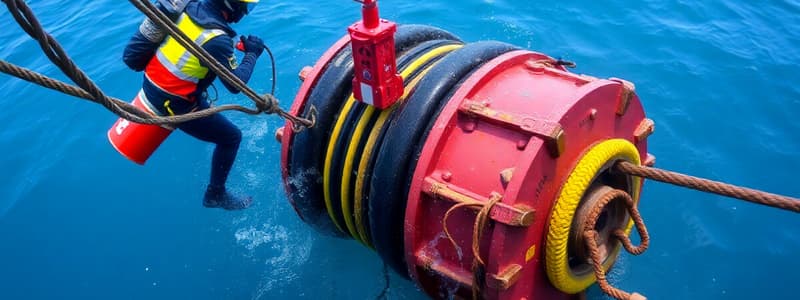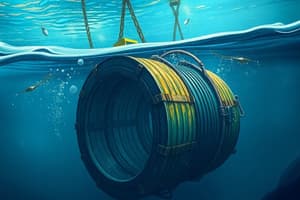Podcast
Questions and Answers
During the subsea spool tie-in operations, what primary factor led the Diving Supervisor to incorrectly assume the crane hook had reached the seabed?
During the subsea spool tie-in operations, what primary factor led the Diving Supervisor to incorrectly assume the crane hook had reached the seabed?
- Visual confirmation via underwater cameras.
- The diver's direct confirmation that the hook was on the seabed.
- Pre-dive checklist sign-off indicating the hook was correctly positioned.
- The crane operator reporting 'no weight' on the crane wire. (correct)
What immediate action demonstrated a positive safety response following the crane hook striking the diver's helmet?
What immediate action demonstrated a positive safety response following the crane hook striking the diver's helmet?
- The Diving Supervisor reprimanding the crane operator.
- Diver 2 offering prompt assistance to Diver 1, ensuring no injuries. (correct)
- Immediate inspection of the crane hook's securing mechanism.
- A detailed review of the JHA.
What control measure could be implemented to improve the monitoring of critical equipment in poor visibility subsea environments?
What control measure could be implemented to improve the monitoring of critical equipment in poor visibility subsea environments?
- Implementing alternative methods such as additional locating beacons, underwater cameras, or sonar. (correct)
- Using only standard communication protocols.
- Increasing the speed of the crane operations to minimise time spent subsea.
- Relying solely on the crane operator's judgment.
What specific aspect of the crane setup was identified as a direct cause of the incident?
What specific aspect of the crane setup was identified as a direct cause of the incident?
Following the incident, what procedural update was implemented to prevent recurrence?
Following the incident, what procedural update was implemented to prevent recurrence?
Flashcards
Subsea Crane Hook Incident
Subsea Crane Hook Incident
During subsea spool tie-in operations, a crane hook unexpectedly struck a diver's helmet due to the crane operator assuming the hook had reached the seabed.
Adequate Distance
Adequate Distance
The length of the crane pennant/stinger should be sufficient to maintain a safe distance between the divers and the crane hook during subsea operations.
Enhanced Visibility Aids
Enhanced Visibility Aids
In environments with poor visibility, alternative methods such as additional locating beacons, underwater cameras, or sonar should be considered to better track the position of critical equipment like the crane hook.
Reinforced Communications
Reinforced Communications
Signup and view all the flashcards
Challenge Assumptions
Challenge Assumptions
Signup and view all the flashcards
Study Notes
- During subsea spool tie-in operations, a crane hook unexpectedly struck a diver's helmet.
What Happened?
- Divers were working on the seabed in poor visibility during subsea spool tie-in operations.
- After landing the pipe handling frame (PHF), the Diving Supervisor told the crane operator to lower the crane hook to the seabed so the diver could disconnect rigging from the crane.
- The crane operator reported 'no weight' on the crane wire, and the Diving Supervisor believed the hook had reached the seabed
- The diver was instructed to disconnect the PHF from the crane
- While the diver was positioned beneath the PHF to disconnect the rigging, the crane hook unexpectedly struck the diver's helmet
- The diver returned to the dive bell unharmed
- The dive was aborted, and inspection revealed irreparable damage to the diver's reclaim helmet, including the side block
- The helmet's integrity was maintained, highlighting the durability of diving helmets
- The diver was unharmed
What Went Right?
- Diver 2 promptly assisted Diver 1, ensuring no injuries, and both divers safely returned to the bell
- Both divers and the crane block had locating beacons for accurate tracking
- Procedures, lifting plans, and Job Hazard Analysis (JHA's) were followed throughout the operation
- Protective equipment worked as intended, and the diver was uninjured due to impact absorption by the helmet
What Went Wrong?
- The crane hook rested on the top beam of the PHF when lowered for PHF rigging disconnection
- Resting on the beam resulted in a 'no weight' reading, leading the operator to assume the hook had reached the seabed
- The hook slipped off the beam and struck the diver's helmet as the diver approached the disconnection point
What Was the Cause?
- The inadequate length of the crane pennant/stinger didn't provide enough distance between divers and the crane hook
- Poor visibility hindered the ability to accurately observe the crane hook's position
Lessons and Actions
- Ensure enough distance between divers and the crane hook
- Use adequate crane pennant/stinger length to maintain a safe distance
- This reduces the risk of accidental contact, especially in limited visibility
- Enhance instruments to improve visibility and monitoring
- In poor visibility, use methods like locating beacons, underwater cameras, or sonar to track equipment such as the crane hook
- Enhanced monitoring can help prevent errors regarding equipment location
- Reinforce communications and challenge assumptions
- Minimize assumptions regarding equipment position.
- Reinforce clear communication between the dive supervisor, crane operator, and divers to ensure everyone is aware of equipment location
- Project procedures specifying minimum pennant lengths for different operations were updated
- Pre-operation inspections of rigging and lifting equipment were conducted to ensure safety standards were met
- The Job Hazard Analysis (JHA) was updated to incorporate lessons on safe distances, visibility, and communication for subsea lifting operations
Studying That Suits You
Use AI to generate personalized quizzes and flashcards to suit your learning preferences.




